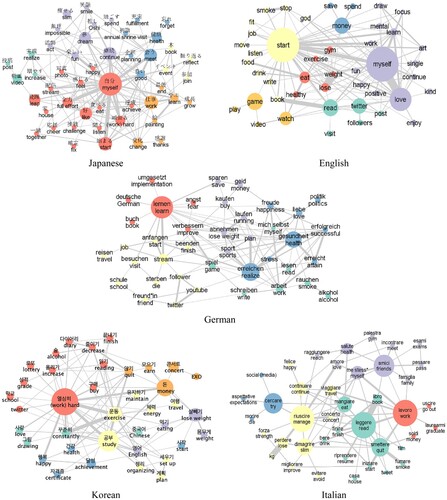Figures & data
Table 1. Value coding scheme with definitions and examples.
Figure 1. Semantic networks of keywords.
Note: Semantic networks of the 50 most frequent words used in 2020 New Year’s resolution tweets in five languages. The size of each node is proportional to its betweenness centrality (a measure of the extent to which it is central to paths in the overall network). The width of a tie between two words is proportional to the number of tweets containing both.

Figure 2. Modes of participation.
Note: Modes of participation in the 2020 New Year’s resolution social media ritual based on a sample of 200 tweets per language (n = 1000). The crosstabulation analysis shows that there is a significant difference between modes across five languages (χ2[12] = 73.23, p < .001). The results of the post hoc analysis are as follows: for resolution, Japanese is a major contributor to the chi-square value (standard residuals [SR] = 5.71, p < .001). For meta-commentary, Italian is a major contributor (SR = 4.20, p < .001) and the German score is a negative predictor (SR = −3.65, p < .001). Lastly, for conversation, German is a positive predictor to the chi-square value (SR = 3.96, p < .001) and Japanese is a negative contributor (SR= −1.71, p < .001).
![Figure 2. Modes of participation.Note: Modes of participation in the 2020 New Year’s resolution social media ritual based on a sample of 200 tweets per language (n = 1000). The crosstabulation analysis shows that there is a significant difference between modes across five languages (χ2[12] = 73.23, p < .001). The results of the post hoc analysis are as follows: for resolution, Japanese is a major contributor to the chi-square value (standard residuals [SR] = 5.71, p < .001). For meta-commentary, Italian is a major contributor (SR = 4.20, p < .001) and the German score is a negative predictor (SR = −3.65, p < .001). Lastly, for conversation, German is a positive predictor to the chi-square value (SR = 3.96, p < .001) and Japanese is a negative contributor (SR= −1.71, p < .001).](/cms/asset/b273b73e-9ee6-4e6b-94d4-4fcc8b70e235/rics_a_1983003_f0002_oc.jpg)
Table 2. A cross-tabulation of values across five languages.
